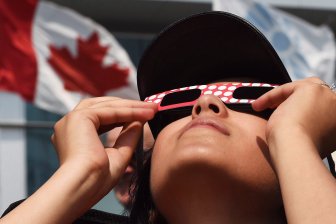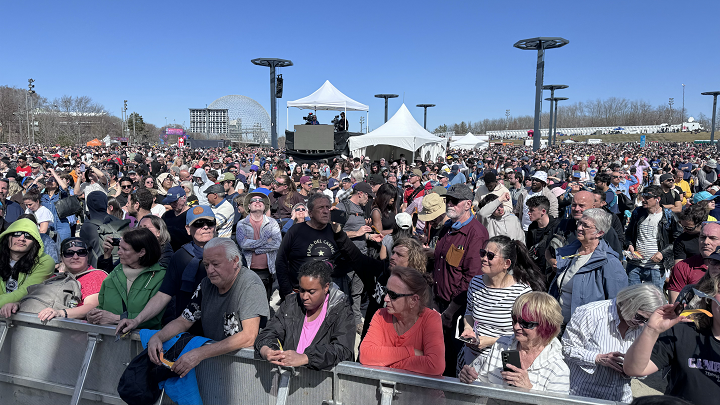A once-in-a-lifetime solar eclipse is passing through portions of eastern Canada, with several cities across Ontario, Quebec and New Brunswick hosting an influx of sightseers ready to stand in utter darkness across the path of totality on April 8.

A livestream began on this page at 1 p.m. EDT and is also available on Global’s YouTube channel.
What time is the eclipse?
The celestial event first hit Ontario from the south just before 2 p.m. EDT on Monday and will depart Newfoundland just after 5 p.m. EDT, or 6:30 p.m. NDT.
Hot spots like Niagara Falls and Kingston, Ont., Montreal, Que., and Fredericton, N.B., will get maximum coverage with some experiencing it for as long as three and half minutes as the moon passes between the sun and Earth.
Provincial and local police services had braced for packed roadways and potential bumper-to-bumper traffic but as of 3:30 p.m. EDT, traffic impacts appeared minimal.
Here’s more on what’s happening at the most popular spots hosting viewing events.
Fort Erie
Expected Maximum Totality (maximum coverage of the sun): 3 mins. 43 secs. between 3:18 p.m. to 3:21 p.m. EDT
Fort Erie, Ont., is the Ontario municipality with the best sightline for the path of totality, equating to the longest time under darkness: close to four minutes.
The northeastern shores of Lake Erie and southeastern Niagara Peninsula will also have totality lasting three-plus minutes.
The last time Fort Erie area saw a solar eclipse was in 1925 and another one won’t be back until 2144.
Hamilton
Expected Maximum Totality (maximum coverage of the sun): 1 min. 47 secs. between 3:18 p.m. to 3:20 p.m. EDT
Hamilton, Ont., is right on the north edge of the path. The first piece of the moon’s shadow appeared just before 2:04 p.m. and the city experienced totality at 3:18 p.m. for about two minutes.
Hamilton designated four large parks, some conservation areas and Tim Hortons Field as ideal viewing sites. While an numeric estimate was not available, a city official said on Friday that all of the 10,000 allocated seats at Tim Hortons Field had been accounted for.
Another total eclipse will not be seen in Hamilton for another 120 years.
Niagara Falls
Expected Maximum Totality (maximum coverage of the sun): 3 mins. 32 secs. between 3:18 p.m. to 3:21 p.m. EDT
The eclipse began its partial phase in Niagara Falls, Ont., at 2:04 p.m. Monday and hit totality at 3:18 p.m. lasting about three and a half minutes.
In January, National Geographic tagged the spot as the “most picturesque” place to view the eclipse with ideal vantage points and the “iconic waterfalls thundering in the background.”
With the city being a reasonable distance from half the population of North America, the spot was an attractive location that had the potential to draw in hundreds of thousands of visitors. However, clouds did not clear out in time for peak viewing.
Still, Global News senior correspondent Jeff Semple said the clouds shifted briefly at the moment of the total eclipse.
“The crowd where we were started screaming,” he recounted.
Several attendees, some travelling as far as Colombia, told Global News’ Caryn Lieberman that they were not disappointed by the clouds and that the experience was emotionally and spiritually moving.
The last time Niagara Falls saw a solar eclipse was in 1925 and another one won’t be back until 2144.
Kingston
Expected Maximum Totality (maximum coverage of the sun): 2 mins. 52 secs. between 3:22 p.m. to 3:23 p.m. EDT
The first partial phase of the event arrived in Kingston, Ont., at 2:09 p.m. on Monday with the path of totality beginning at 3:22 p.m. and lasting just under three minutes.
As was the case in Niagara Falls, weather conditions were not ideal as clouds remained, but cheers could still be heard as attendees witnessed the skies grow dark.
Montreal
Expected Maximum Totality (maximum coverage of the sun): 1 min. 26 secs. between 3:26 p.m. to 3:27 p.m. EDT
Montreal, Que., is also right on the north edge of the path of totality with a partial phase that began at 2:14 p.m. on Monday before it made its way to total darkness just before 3:27 p.m. lasting about a minute and a half.
The city’s Espace pour la Vie, which consists of five natural museums teamed up with Parc Jean-Drapeau to host what could be up to 80,000 people. Attendees began arriving at the park as early as 7 a.m. Monday and organizers have said they have 150,000 eclipse glasses to give out free of charge.
Crowd estimates are not yet available but the forecast has cooperated for ideal viewing conditions under clear skies. Cheers could be heard outdoors in Montreal at the moment of peak darkness.
According to the city, the last total eclipse in Montreal happened in 1932.
Other Quebec municipalities in the path of totality include Sherbrooke, Lac-Mégantic, and Cap-aux-Meules with the total solar eclipse taking place between 3:25 and 3:40 pm. depending on the region.
Fredericton
Expected Maximum Totality (maximum coverage of the sun): 2 min. 12 secs. between 4:33 p.m. to 4:35 p.m. ADT
The first sighting in Fredericton, N.B., started with a partial phase emerging 3:23 p.m. local time on Monday and the path of totality began at 4:33 p.m. lasting just over two minutes.
Other areas that experienced 100 per cent totality include Woodstock, Florenceville-Bristol and Miramichi.
Each of those venues will see the sun’s light covered by the moon for just over three minutes.
In Miramichi, a large crowd had amassed at the local airport by midday and as many as 15,000 were expected in total with clear skies creating the ideal viewing conditions.
P.E.I. and Newfoundland
Expected Maximum Totality (maximum coverage of the sun): 3 min. 15 secs. between 4:35 p.m. to 4:38 p.m. ADT in northern P.E.I.; 2 min. 54 secs. between 5:15 p.m. to 5:16 p.m. NDT in eastern Newfoundland
The path of totality also includes the northern half of Prince Edward Island, a sliver of the northern tip of Nova Scotia and throughout central Newfoundland.
In fact, Newfoundland will be the destination of the final viewing of the eclipse in North America.
— With files from Global News’ Shane Gibson, Annabelle Olivier and Rebecca Lau.













Comments